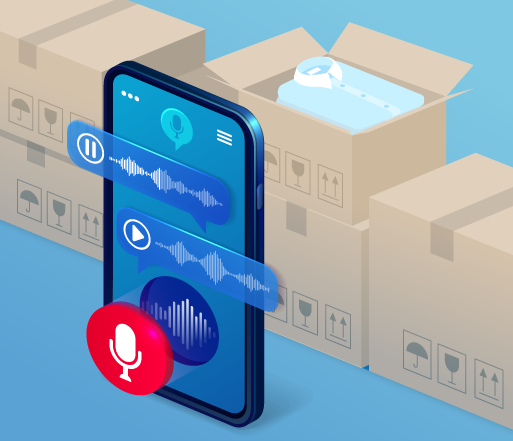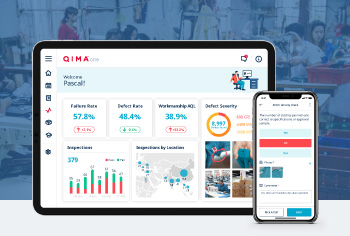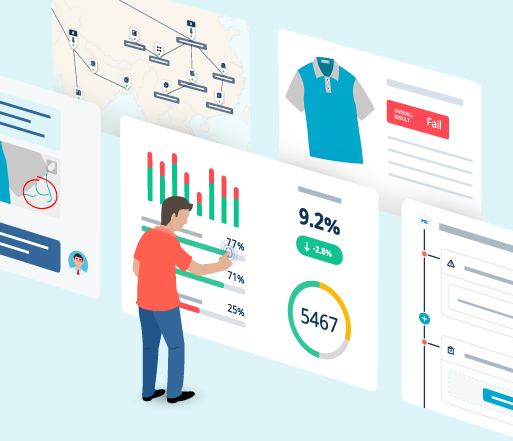
ARTICLE
How to use voice command to improve quality control processes

ARTICLE
How to use voice command to improve quality control processes
ARTICLE
How to use voice command to improve quality control processes

Keep up-to-date with the latest supply chain insights.
What used to be science-fiction is quickly becoming science-fact through the expanded use of rapidly improving voice recognition technology. The speech and voice recognition market is expected to be worth US $26.8 billion by 2026, with a compound annual growth rate of 17.2%.
Today’s technology includes voice assistants, such as Apple’s Siri and Amazon’s Alexa, which have become members of millions of households and workplaces. Speech recognition tools have sprouted up in several industries, including healthcare, retail, financial services and education.
More and more, users are getting comfortable with talking to their machines. The developments in technology and user expectations present opportunities to use voice recognition in a growing number of applications, including quality control.
Using Voice Command Technology for Quality Control: What does it look like?
One application of voice recognition technology in the supply chain is to help warehouse workers, according to Mark Hendricks in All Business. Workers receive an order, pick it from the shelf for packing, and speak to the server through a headset to report the order’s completion.
The benefits of the technology can be substantial, Hendricks writes, allowing warehouses to operate with fewer employees while maintaining near-100% order fulfillment accuracy.
Similar work can be done in quality control as inspectors or auditors use the same technology to record their observations, taking advantage of the hands-free interface to keep their attention on the products they’re reviewing.
When an inspection platform is powered by voice recognition, minimal training is required and brands unlock a degree of accuracy that matches human transcribers. Notably, most consumers and businesses are already familiar with the functions of speech recognition technology, which means the inspectors will already have a good idea of how the technology works. Armed with just a tablet or other mobile device, inspectors simply speak up and upload their data directly and immediately to a cloud-based system.
A More Accurate and Efficient Quality Control Program
The real benefits of voice technology that improve supply chain processing and streamline various aspects of inspections are the way it allows for more efficient, more accurate reporting of inspection results.
Measurement recording is the most time-consuming task for an inspector. Voice recognition transforms the process and makes it significantly leaner and more accurate. Often, two people are required to take measurements, with one using the measuring device and the other noting the results.
With voice command, just one inspector can do the same amount of work, without having to worry about taking a break to write notes as they inspect. This eliminates the chances of recording errors, handwriting sloppiness, or unclear usage of inspection forms, and helps maintain the flow of product and the consistency of the inspection process. Documentation becomes more efficient and precise, as voice recording eliminates the need to interpret poor handwriting or misplaced notations.
Voice recognition technology also enables inspectors to be more hands-on with the product as necessary. This allows for more precise, more comprehensive measurements. The quality control program can include more categories for measurement thanks to improved efficiency and more focused inspector attention, which means products are more likely to meet your quality control specifications.
All told, voice recognition technology improves quality control by reducing human error, saving time, and strengthening the overall inspection process.
Find out how you can transform your quality and compliance with QIMAone.
REQUEST DEMO
Find out how you can transform your quality and compliance with QIMAone.
REQUEST DEMOEmpower Your Partners
Among the many benefits a digitized supply chain provides, the most promising is that end-to-end visibility can potentially overhaul and reinvent the supplier relations framework. In fact, businesses with a high degree of supply chain digitization are 50% less likely than their less digitally savvy counterparts to suffer from poor supplier communication and serious product quality issues, according to a recent survey of global businesses conducted by QIMAone.
Thanks to real-time visibility on the factory floor and accurate measurements, partners and employees are empowered to make decisions based on real-time data. Furthermore, relationships between businesses and suppliers are no longer formed on a standard client-vendor contract. You can build on continuous improvement and aligned goals.
Speech recognition technology is key to building these new supplier relationships based on trust, transparency, and teamwork – literally and figuratively amplifying the voices of suppliers, partners and employees in the supply chain inspection process. When done right, all parties are heard, and everyone wins.
Voice Recognition and the QIMAone Software Platform
With the introduction of the QIMAone software platform, you can digitize your entire supply chain, complete with state-of-the-art voice recognition capabilities that increase your quality control efficiency and accuracy.
QIMA and its QIMAone software platform can help you find the maximum value in all of your products. To learn more about how a QIMA partnership can be helpful to you and your company, contact us today.
The QIMAone software might not give you the technological advantage of Jean-Luc Picard in Star Trek, but it’s the next best thing for keeping you and your company ahead of the competition.
Most Popular Articles
Corrective Action Plans 101: Your Basic Guide to Ensuring Supply Chain Quality Excellence
The Benefits of a Data-Driven Supply Chain
6 Benefits of Supply Chain Visibility
How to Implement a Quality Management System
Simpli Home: Ensuring product quality and compliance with supply chain technology
7 Effective Ways to Improve Your Quality Management System
Supply Chain Visibility: Complete Guide for Supply Chain Managers
Boost Quality Control with Supplier Performance Metrics





